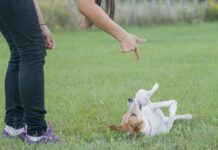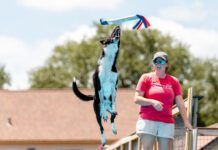The “Search!” game uses lots of energy and can tire out even very active dogs, and offers very practical applications as well. Start with treats, since most dogs will happily look for food. You can eventually ask your dog to look for hidden objects (favorite toys, your lost keys) and even hidden or missing humans! Here’s how to start:
Step 1: Have your dog sit and stay. (If he doesn’t know sit/stay, have someone hold his leash.)
Walk about six feet away, show him a treat, remind him to stay, and place the treat on the ground.
Return to his side (don’t let him get up yet!), turn and face the treat, then tell him “Search!” (If he won’t get up until you release him from the stay, say, “Search!” and then give your release cue.) He should run right out and eat the treat. Repeat a half-dozen times.
Step 2: Have your dog sit and stay.
Let him watch you “hide” a treat in plain view (next to a chair leg, by a waste basket, etc.).
Return to his side (don’t let him get up!), turn and face the treat, then tell him “Search!” He should run right out and eat the treat. Repeat a half-dozen times.
Step 3: Have your dog sit and stay.
Let him watch you hide several treats in plain view.
Return to his side (don’t let him get up!), turn and face the treats, rub one of the treats you’re using on a paper towel, hold the towel in front of his nose (don’t let him eat it!) and tell him “Sniff!” (Don’t worry if he doesn’t appear to sniff it.)
Then tell him “Search!” He should run right out and eat the treats. Repeat a half-dozen times, having him “Sniff” before each set.
Step 4: Have your dog sit and stay.
Let him watch you hide a treat where he can’t immediately see it (such as behind a chair leg). Note: It’s easier to find a treat on the ground and more difficult to find one on a raised surface.
Return to his side (don’t let him get up!), turn and face the treat, tell him “Sniff!” and then say “Search!” He may have more trouble finding this treat. Don’t help him! This is where he starts learning to use his nose. If you help him, he won’t use his nose. If he truly can’t find it, reset, and hide it in an easier spot. Make sure he watches you!
Repeat a half-dozen times. Gradually hide the treat in harder places, having him “Sniff” the paper towel before each set.
Step 5: Have your dog sit and stay.
Let him watch you hide two to three treats in somewhat easy places (behind a chair leg, etc.)
Return to his side (don’t let him get up!), turn and face the treats, then tell him “Search!” He may have more difficulty finding multiple treats. If necessary, indicate an area by spreading your arms and saying “Search here!” Don’t point to the treat! If he truly can’t find the treats, reset, and hide them in a slightly easier spot. Make sure he watches you!
Repeat a half-dozen times. Gradually hide treats in harder spots, having him “Sniff” the paper towel each time before you send him.
Step 6: Put your dog in another room.
Hide two to three treats in somewhat easy places.
Bring him back to the room, have him “Sniff!” the paper towel and then tell him “Search!”
Repeat a half-dozen times, doing “Sniff” each time.
Gradually hide treats in harder spots.
Step 7: Generalize his “Search” behavior to other objects as you desire, starting with a favorite toy. Rub the toy on the paper towel, and proceed as your dog needs. Start back at Step 1, placing the toy in plain view and move quickly through to Step 6.
Then use less favorite or neutral objects, starting at Step 1 and moving quickly to Step 6. For humans, have the object of your search rub a paper towel on his or her neck, and then have the person hide. Start with having the person “hide” in plain sight at first, and then in increasingly more hidden places. Start at Step 1, and move quickly through Step 6.
Step 8: Remember to have fun!!
Read our accompanying article: When One Is Not Enough.





